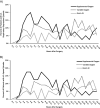Incidence of postoperative opioid-induced respiratory depression episodes in patients on room air or supplemental oxygen: a post-hoc analysis of the PRODIGY trial
- PMID: 37794334
- PMCID: PMC10548743
- DOI: 10.1186/s12871-023-02291-x
Incidence of postoperative opioid-induced respiratory depression episodes in patients on room air or supplemental oxygen: a post-hoc analysis of the PRODIGY trial
Abstract
Background: Supplemental oxygen (SO) potentiates opioid-induced respiratory depression (OIRD) in experiments on healthy volunteers. Our objective was to examine the relationship between SO and OIRD in patients on surgical units.
Methods: This post-hoc analysis utilized a portion of the observational PRediction of Opioid-induced respiratory Depression In patients monitored by capnoGraphY (PRODIGY) trial dataset (202 patients, two trial sites), which involved blinded continuous pulse oximetry and capnography monitoring of postsurgical patients on surgical units. OIRD incidence was determined for patients receiving room air (RA), intermittent SO, or continuous SO. Generalized estimating equation (GEE) models, with a Poisson distribution, a log-link function and time of exposure as offset, were used to compare the incidence of OIRD when patients were receiving SO vs RA.
Results: Within the analysis cohort, 74 patients were always on RA, 88 on intermittent and 40 on continuous SO. Compared with when on RA, when receiving SO patients had a higher risk for all OIRD episodes (incidence rate ratio [IRR] 2.7, 95% confidence interval [CI] 1.4-5.1), apnea episodes (IRR 2.8, 95% CI 1.5-5.2), and bradypnea episodes (IRR 3.0, 95% CI 1.2-7.9). Patients with high or intermediate PRODIGY scores had higher IRRs of OIRD episodes when receiving SO, compared with RA (IRR 4.5, 95% CI 2.2-9.6 and IRR 2.3, 95% CI 1.1-4.9, for high and intermediate scores, respectively).
Conclusions: Despite oxygen desaturation events not differing between SO and RA, SO may clinically promote OIRD. Clinicians should be aware that postoperative patients receiving SO therapy remain at increased risk for apnea and bradypnea.
Trial registration: Clinicaltrials.gov: NCT02811302, registered June 23, 2016.
Keywords: Apnea; Capnography; Continuous monitoring; Pulse oximetry; Respiratory depression; Room air; Spot check monitoring; Supplemental oxygen.
© 2023. BioMed Central Ltd., part of Springer Nature.
Conflict of interest statement
TNW, AKK, SDB, and RDU or their institutions received financial support from Medtronic to fund the original trial. In addition, TNW reports personal fees from Merck; RDU reports funding and/or personal fees from Merck, Medtronic, AcelRx, and Pfizer; AKK reports consulting fees from Medtronic, Edwards Lifesciences, Philips Research North America, GE Healthcare, Baxter, Retia Medical, Caretaker Medical, Trevena Pharmaceuticals, Renibus Therapeutics and support via an NIH/NCATS KL2 award for a trial of continuous portable monitoring on hospital general care floors. FDP and MS report full time employment with Medtronic during the time of the work. MLL, CND, and AGD declare that they have no competing interests.
Figures



References
-
- Khanna AK, Bergese SD, Jungquist CR, Morimatsu H, Uezono S, Lee S, et al. Prediction of opioid-induced respiratory depression on inpatient wards using continuous capnography and oximetry: an international prospective. Observ Trial Anesth Analg. 2020;131(4):1012–1024. doi: 10.1213/ANE.0000000000004788. - DOI - PMC - PubMed
-
- Ramachandran SK, Thompson A, Pandit JJ, Devine S, Shanks AM. Retrospective observational evaluation of postoperative oxygen saturation levels and associated postoperative respiratory complications and hospital resource utilization. PLoS ONE. 2017;12(5):e0175408. doi: 10.1371/journal.pone.0175408. - DOI - PMC - PubMed

